As you are looking for things that can be corrected in your golf swing, try to find ways to use your big muscles more and your small muscles less. Your big muscles are easier to control throughout the swing, allowing you to achieve greater consistency. Many amateur golfers rely too much on the smaller muscles in their hands and arms, leading to a swing that will never be repeatable from shot to shot. If you watch the professionals play on TV, you will notice that their swings are very simple, as they allow the big muscles to do the majority of the work. Place control of your golf swing into the big muscles of your torso and legs and you will soon begin to see better results.
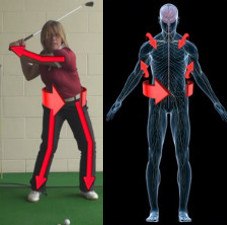
Beyond taking the flaws out of your swing, there is another great reason to use your big muscles – additional power. Using the big muscles of your body to move the golf club through the backswing and follow through will open up the potential for power that you may not have known you were capable of creating. If you have ever seen a player use a seemingly simple and smooth swing to blast long drives down the middle of the fairway, it is a safe bet that player was using his or her big muscles nicely. The big muscles contain the 'secret' to powerful golf shots, so it is certainly worth your time to explore improving your swing in this area.
To make a good golf swing, you need to use your muscles. Of course, to do anything as a human being, you need to use your muscles – so the fact that they are involved in the golf swing shouldn’t be surprising. But how can you use your muscles most effectively on the course? Which muscles should be playing an active role and which ones should stay out of the way? In this article, we will explore those questions and more.
| GOLF FIXES BY PGA PROS |
|---|
| The Advantages Of Using The Core Muscles Correctly During The Golf Swing | Video | Article |
| Correct golf swing flaws with big muscles | Video | Article |
| Correct Your Golf Swing Flaws By Using Your Big Muscles | Video | Article |
| Muscle Memory Key To Golf Consistency – Practice Under Pressure | Video | Article |
| LESSONS |
|---|
| How Do The Core Muscles Work During The Golf Swing | Video | Article |
| Golfer Ernie Els, Big Muscles Power Effortless Golf Swing | Video | Article |
| How Do The Core Muscles Work During The Golf Swing | Video | Article |
| Implementing Big Muscles During The Golf Swing | Video | Article |
| Pre-Round Golf Preparation For Your Big Muscles | Video | Article |
| Understand What Big Muscles You Use During The Golf Swing | Video | Article |
| Big Muscles Help Create Flawless Swing | Video | Article |
| Use The Bodys Big Muscles For Effortless Golf Swings | Video | Article |
| Big Muscles Matter In Your Golf Short Game | Video | Article |
| Big Muscles Move Slower In Your Golf Swing | Video | Article |
| Proper Use Of The Big Muscles Creates a Flawless Golf Swing | Video | Article |
| Choosing Which Big Muscles To Focus On During The Golf Swing | Video | Article |
| Evaluate Which Big Muscles You Use During The Golf Swing | Video | Article |
| Golf Pro Darren Clarke: Core Muscles Power the Swing | Video | Article |
| The Mental Side Of Golf: Correct Muscle Memory is Necessary to Golf Consistency | Video | Article |
| Muscle Memory Key To Golf Consistency – Basics Of Practice | Video | Article |
| Muscle Memory Key To Golf Consistency – How Practice Helps Consistency | Video | Article |
| Muscle Memory Key To Golf Consistency – How To Practice On The Range | Video | Article |
| Muscle Memory The Key To Golf Consistency – Success Under Pressure | Video | Article |
| Muscle-Bound Golfers: Swing Involves More Than Just Arms | Video | Article |
| GOLF QUESTIONS |
|---|
| How Can My Big Muscles Control My Golf Swing? | Video | Article |
| GOLF EXERCISES |
|---|
| Pre-Round Core Muscle Stretch | Video | Article |
It’s important to understand that successful golfers come in all shapes and sizes. You don’t have to be a body builder to play good golf – far from it. It does help to be a good physical condition, as those who are fit will usually be able to make a better turn and create more speed. However, even if you aren’t quite the picture of fitness at the moment, you can still use your muscles to create the best possible swing for your body.
The content below is based on a right-handed golfer. If you happen to play left-handed, please take a moment to reverse the directions as necessary.
— The Key Muscle Groups
While your entire body is going to be involved in the swing in one form or fashion, there are certain muscle groups that are more important than others when hitting the ball. In this section, we’d like to highlight which muscles are going to play a big role in your swing, so you can get a basic understanding of how it all fits together.
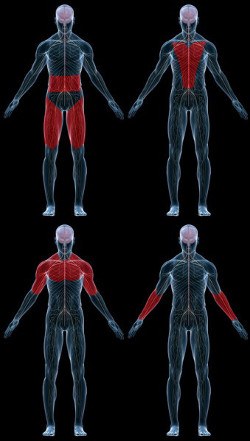
- Big muscles in your legs. We start with your lower body because the muscles in your legs will have a lot to say about the overall quality of your swing. If you can build a solid platform for your swing in the lower body, it will be easier for the upper body to do its job. Specifically, the glutes and quads are going to be particularly involved in establishing a solid base. It’s crucial to flex your knees at address because that action is going to engage those muscles and allow them to get involved. Your quads and glutes may not play any role at all in actually moving the club, but they are essential if you are going to create a foundation for the kind of powerful, repeatable swing that leads to quality shots.
- Back. Unfortunately, the important role that your back plays in the golf swing can be seen by looking at just how often golfers run into back trouble. It’s not uncommon for back pain or stiffness to affect a golfer, which is an indication of just how active this part of the body is when swinging the club. You’ll use your back to find a solid posture over the ball at address, and you’ll continue to use it all the way until the swing is finished. While strength in your back can help to produce good shots, it is really flexibility in this area that is most desirable. Plenty of flexibility will enable you to make a good turn, and that good turn can allow you to strike the ball with more speed than ever before.
- Shoulders. The muscles of your shoulders certainly have some work to do in the swing as well, since this is where the connection from your back out into the club starts to get going. The shoulders are going to help lift the club up into place, although that will be a gradual move that will take place as the backswing is developing.
- Hand and wrist muscles. Things can start to get a bit tricky when you talk about the small muscles that get involved in the swing. The muscles that operate your hands and wrists are essential in golf, of course, but you don’t want to let them do too much – or get involved at the wrong time. The key here is to use these small muscles when they are needed and keep them quiet the rest of the time. For a good example of this concept, we can look to the early stages of the backswing. The start of the backswing, known as the takeaway, is a key moment in the swing and your hands and wrists should not be involved at this point. However, as soon as you are a little farther into the backswing, your wrists can start to set the club by lifting it up into place as you turn. If you get started too early with this subtle wrist action, you’ll put the club in the wrong place, and it will be hard to recover. As you can see, there is a fine line between using your hands and wrists correctly and letting them send you down the wrong path. A big part of what you have to learn in golf is how to use the right muscles at the right time – and we will talk more about that topic in the next section.
Reviewing the list above, your big leg muscles, back, shoulders, and hands/wrists all have a lot of work to do in the swing. With that said, you really shouldn’t be thinking about the specific muscle groups one at a time as the swing moves along. Instead, you should just be focused on executing solid technique while letting the muscles jump in naturally and do their work. That’s really what practice in golf is all about – teaching your body how to do the job so you don’t have to think so much about it as it happens. For an experienced player, there won’t be so much as a single though about what muscles need to perform what action at what time. Rather, it will just happen, so the player will be free to think about things like strategy, the lie of the ball, weather conditions, and on and on. There is a lot to think about in golf, so automating your swinging action to the greatest degree possible is a big help.
— Wrong Muscles at the Wrong Time
As mentioned above, you need to use your muscles at the right time and in the right manner to get the job done on the course. In this section, we are going to take a look at some of the things that you don’t want to do during the swing – or at least, things you don’t want to do when the time is wrong. You might recognize some of these mistakes from your own game, and that’s okay. If you are making some of these errors currently, understanding why they are a problem is a good first step toward improving.
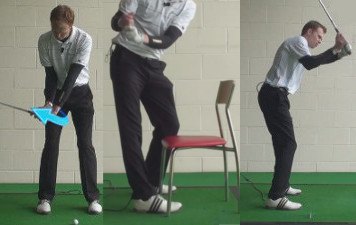
- Hands in the takeaway. Okay – so we already talked about this one once, but it is important enough to review again. Letting your hands do the work of moving the club away from the ball is a problem for a couple of reasons. First, it is likely to move the club to the inside of the desired target line, so you’ll have to make an adjustment for that error later in the swing. Most likely, that adjustment won’t happen, and you’ll simply hit a poor shot as a result. Another issue with using your hands to start the swing is what this move can do to your tempo. Small muscles like those in your hands tend to move more quickly than do big muscles, so you might feel like your swing is rushed when you start with hand action. A smooth, even tempo is best in this game, but that will be hard to accomplish if you are making a quick takeaway with your hands and wrists. You might be surprised to find just how much your tempo can improve if your simply switch to a one-piece takeaway where your shoulder rotation is responsible for moving the club back away from the ball.
- Legs moving up at the top. Some golfers use the action of extending their legs down through the hitting area to add power to the swing. This is somewhat of an advanced move, but it can pay off in a big way if you know how to execute it properly. It’s possible to push off the ground by straightening your legs and help the club whip through the hitting area. However, while that straightening of the legs can be a great action down through impact, it’s a big problem if you do it earlier in the swing. If you straighten your legs as you get up toward the top of the backswing, which is a common mistake, you’ll be making all sorts of problems for yourself. Not only will this move put the club out of position, but it will also make it difficult for you to develop any kind of meaningful speed on the way down. When you get up to the top of the swing, you need to keep your legs engaged and your knees flexed so you can start to turn toward the target aggressively.
- Hands starting the downswing. Yet again, we see another point where using your hands too actively can cause trouble. This time, we are talking about the transition from the backswing to the downswing. If you use your hands and wrists to start moving the club down, rather than using the rotation of your body to pull the club into position, it is going to be hard to hit good shots. In fact, this is the move most commonly associated with a slice. Those who unhinge their wrists at the top of the swing to get the downswing going usually put the club outside of the proper path, and they wind up hitting across the ball weakly at impact. If you have long been struggling with a slice and you have never managed to figure out where it was coming from, this ‘casting’ move at the top of your swing is likely to blame. Quiet your hands down in the transition and you may see your slice disappear sooner rather than later.
There are plenty of ways for your muscles to work against you in the golf swing, but the list above highlights some of the key issues faced by the average golfer. So much of golf is about avoiding common mistakes, so reviewing this list and checking your own swing for these errors is a good step toward better play.
— Working on Fitness
It’s long been established that you don’t need to be a high-end athlete to play golf successfully. Over the years, there have been plenty of successful professional players who were not in top physical condition. Of course, that has largely changed in recent years, as the way Tiger Woods approached fitness and golf has made a big impact. Today, most of the top players are in good overall shape, and some would even fit right in if they were placed in other professional sports. To be sure, it’s been proven over the last couple of decades that being in good physical condition can help you play better golf.
So, if you would like to improve your game, it might be wise to work on your body as well as your technique. Below, we have highlighted a few of the things you may wish to focus on as you turn your attention toward fitness. Of course, before starting any new exercise routine, always check with your doctor. And, if you decide to do some weightlifting and you don’t have previous experience in this area, consider working with a trainer at first so you can learn how to lift safely.
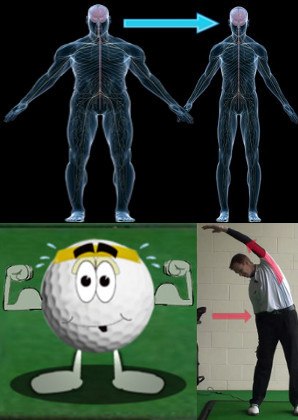
- Maintain a healthy weight. There are so many reasons to focus on maintaining a healthy weight in your life, and most of them have nothing to do with golf. However, even if you are thinking only from a golf perspective, it’s still a good idea to manage this part of your fitness. Maintaining a healthy weight can help your golf game in a few different ways. For one thing, with less of you around the middle to move, it will be easier to make a big turn back and through. A big shoulder turn goes a long way toward hitting powerful shots, but it’s hard to make that turn with extra weight around your midsection. Another important component of managing your weight is the endurance you have on the course. Sure, golf might not seem like much of an endurance sport, but it’s easy to get tired toward the end of a long 18-hole round. That is particularly true if you are walking the course and carrying a little more weight than would be ideal. Your legs are probably going to get tired by the end of the day, and it’s hard to make good swings without the support of your legs. If you have been looking for motivation to lose a bit of weight anyway, you might be able to use your golf game as the spark you needed to get started.
- Focus on flexibility. It’s hard to overstate the importance of flexibility on your golf game. Remember, this is a game that’s all about rotation, and you need to be flexible in order to rotate properly. Many people focus on their back when thinking about golf flexibility, and that’s a great place to start, but don’t forget about your legs. Specifically, it is helpful to be flexible in the upper portion of your legs, as this will allow you to stay down in your stance as the swing develops. Those with tight hamstrings, for instance, have trouble keeping their knees bent at the top of the swing. Any good golf fitness routine is going to focus on adding as much flexibility as possible throughout the body.
- Add strength wisely. Making your body stronger can certainly help you on the golf course. With more muscle, you should be able to swing the club faster, and you may find that your body holds up better over the course of the day. However, it’s important to go about building muscle in the right way if you want to see good results. For starters, you need to avoid getting injured, as hurting yourself weightlifting could keep you off the course for some time. Work your way slowly into this fitness activity, as lifting too much too soon is a common mistake and one likely to lead to injury. As mentioned above, don’t be afraid to get help if you are new to working out in a gym. There is a lot to learn about weightlifting and getting help with the basic techniques from an experienced trainer could go a long way toward making your workouts successful.
It’s up to you how much you decide to make fitness a part of your golf game. Some people go all in on this side of the game and doing so certainly could help you play better golf in the months and years to come. Of course, getting your body in better shape is also a good thing for life away from the course, so you plenty of return on your investment of time and effort in this area.
— Which Muscles Work in the Short Game?
It would be a mistake to finish this article without discussing the short game and how your muscles should work to hit putts and chip shots. The picture is far simpler here than it is in the long game, but that doesn’t mean it’s easy. You’ll need to know exactly what you are trying to do so you can practice the right moves over and over again.
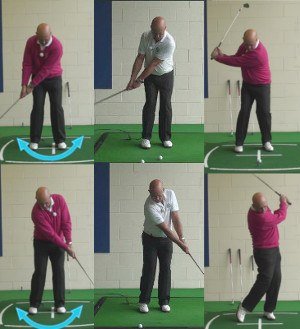
- Putting. When hitting putts, you should be using the big muscles of your upper body to rock the club back and forth – and everything else should be almost perfectly still. You will engage your leg muscles to build a solid platform for the putting stroke, but they won’t move during the stroke. Simply bend your knees at address to get set, and then do your best to hold that lower body position all the way through. To move the putter, the feeling you should have is one of rocking your shoulders back and through. If you can make this motion without letting your hands or wrists get involved in the stroke, you should be well on your way to knocking in more than your fair share of putts.
- Chipping. For the most part, your chipping action is going to look like your putting action, with the exception of a little more wrist action to set and release the club. Since you need to hit down on your chip shots, unlike your putts, you’ll want to use your wrists just a bit in the backswing to set the club and get some angle. From there, you can hit down through the ball while letting your right wrist unhinge just enough to deliver the club to impact. Chipping should still be a simple overall action so you can repeat it time after time for consistent results.
- Bunker play. You’ll use more muscles when hitting greenside bunker shots than when putting or chipping. In fact, the technique you use in a greenside bunker is going to look pretty similar to your full swing, only on a slightly smaller scale. You’ll need to use your hands and wrists aggressively through impact on these shots in order to move the club into the sand and under the ball effectively. That hand and wrist action, combined with a big shoulder turn, will provide the speed needed to cut the clubhead through the sand. Practice plenty of greenside bunker shots whenever possible so you can get comfortable with how much effort is needed to hit this relatively short shot.
We hope this article has given you plenty to think about, and at least a few things to work on in your game. Optimizing the way your muscles work during the swing should help you put the club in a better position at impact – and you should be able to produce improved shots and lower scores. Have fun out there and good luck!






